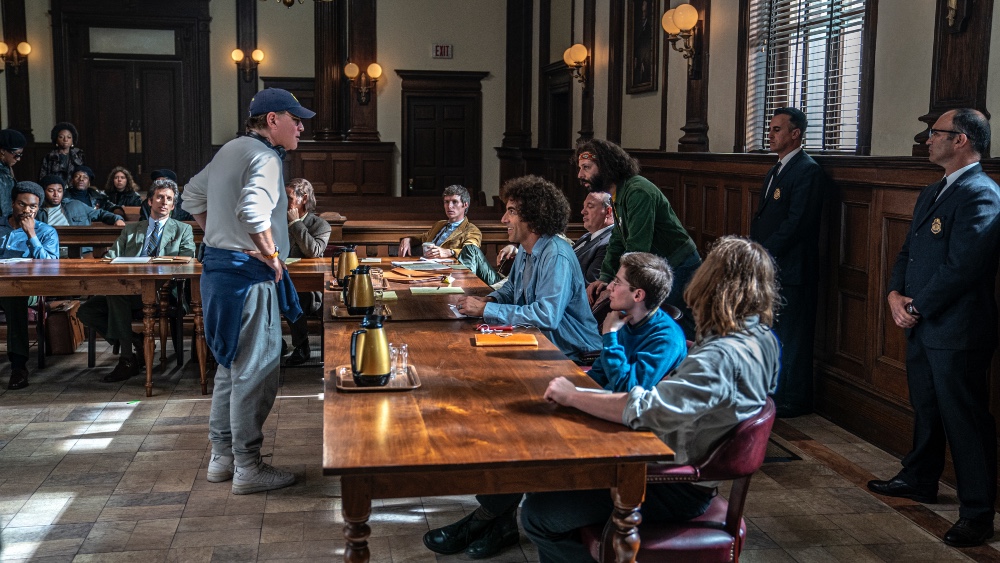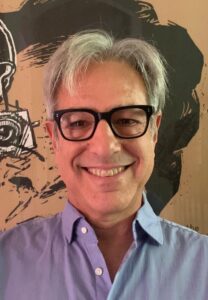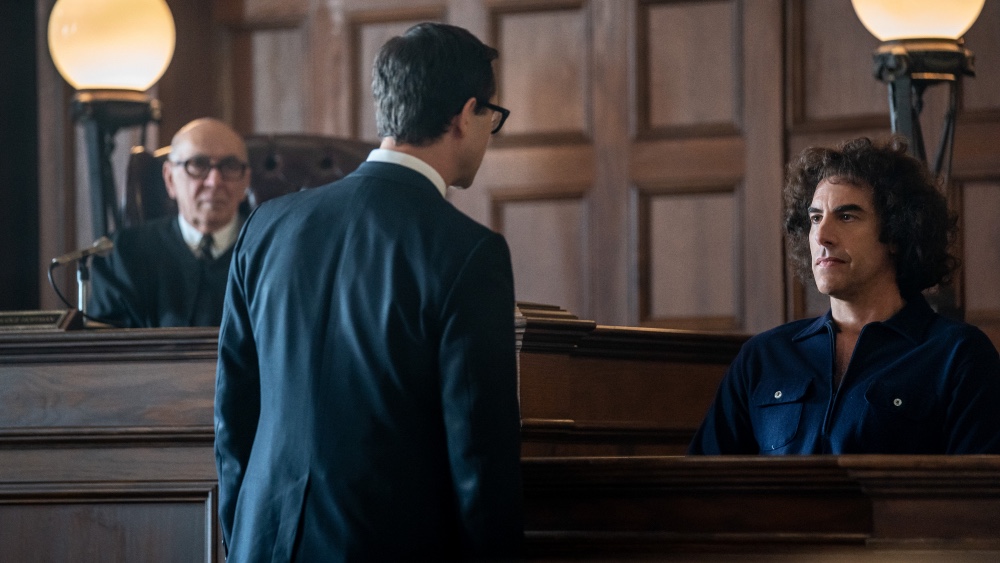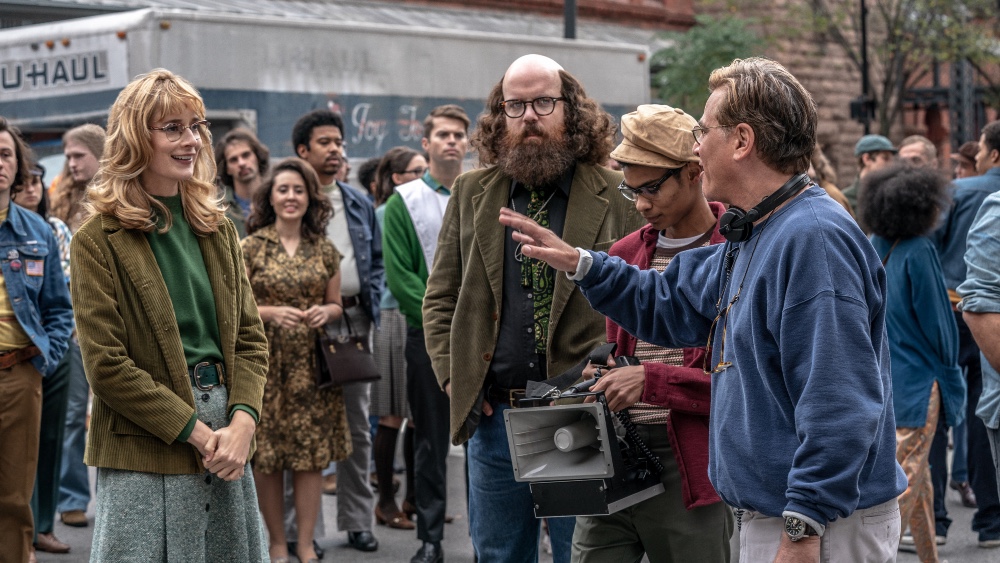
Writer and director Aaron Sorkin tried for years to make The Trial of the Chicago 7, a fact-based drama about the aftermath of riots during the 1968 Democratic Convention to nominate a Presidential candidate. With an ensemble cast, shifting timelines, conflicting narrative threads, and Sorkin’s trademark information-packed dialogue, Trial was not an easy sell.
Originally planned for a theatrical release through Paramount Pictures, Trial became a Netflix project instead. Despite its limited budget and short shooting schedule, the finished film was a fixture on last year’s Ten Best lists and is an Oscar contender in several categories.
Part of the credit for the film’s success goes to Editor Alan Baumgarten, who collaborated with Sorkin earlier on Molly’s Game. Baumgarten spoke with Below the Line from Los Angeles.
Below the Line: When you started on this movie, did you realize it would be so timely?
Alan Baumgarten: I was set to join this in 2018 when it was almost ready to go, but production was delayed another year. The goal when we started was for it to be out in time for the 2020 election. Aaron and I’m pretty sure everyone involved on this film knew it would have some relevance because it was an election year, but we had no idea how it would be amplified by some unfortunate events to make it even more timely.
BTL: Did the Covid-19 pandemic have any impact on your work?
Baumgarten: We were caught in the throes of it midway through. They finished shooting around Christmas, 2019. I did my editor’s cut and went into the director’s cut with Aaron for ten weeks. We finished that right when the Covid protocols were put into place, so we had to work remotely.
We showed the studio our edit and then went into fine cutting, notes, all the finishing, which went on for months. The musical score, the sound mixing, the color timing — all of that was done remotely. Aaron and I were on Zooms and phone calls with each other until we finished in August.

BTL: Was there a lot of footage to work with?
Baumgarten: I would say an average amount, because it was a tight schedule. Large credit to [Director of Photography] Phedon Papamichael and the entire production team for maximizing the resources they had. Several cameras were shooting at once, so I had a variety of material. That was key — not so much the volume of material, but the choices, the variations on different sizes of shots, different angles, coverage on different characters.
BTL: Does Sorkin work with a shot list?
Baumgarten: Aaron may not shotlist, but he knows what he wants to cover. Obviously, he wants the people who are speaking the dialogue, but he knows we have to have coverage of the judge, the jury, etc. I would converse with Aaron and Phedon at times just to double check and make sure they were getting me as much as they could, because everybody needed to be covered all the time. Without a long schedule, that was a big challenge.
BTL: According to Papamichael, Sorkin often wouldn’t be looking at the monitor after a take.
Baumgarten: That’s a good story, and it’s true, but only to a certain extent.
The words, the rhythm, the cadence, delivery, and performance of the script are what’s most important. Aaron’s listening, as all directors do to get what they want out of a shot or out of a scene. Basically, he’s keying in on performance. So if he has his eyes closed or he’s not looking at the monitor for a moment, it’s because they are doing multiple takes and he’s trying to feel that he has the right performance.
BTL: What do you think he expected from you?
Baumgarten: He wanted to know what I could bring to the script in terms of finding ways to enhance or elevate the material. If I can find something that surprises him, he’s always encouraging me to do that. A reaction shot, a different way to portray an emphasis in a scene. Stock footage was one area in which he gave me free rein, although I felt I had free rein in every respect really to try things, show him ideas. That would sometimes spur him on to new ideas of his own. It was a great back and forth.
BTL: This is a dense film with a lot of information. Did you have an overall approach or strategy?
Baumgarten: The challenge in breaking down the script is that Aaron was trying to tell three stories simultaneously: the trial obviously, but also how the protests turned into riots, and the conflict on a more personal level between Tom Hayden [played by Eddie Redmayne] and Abbie Hoffman [Sacha Baron Cohen].
In addition, you had multiple timelines where we were shifting from the present to the past, the present being the courtroom and the office where the defendants would hang out when they weren’t on trial, and Abbie doing his stand-up before college audiences. Each of those locales would launch us into flashbacks.
So within those structures, I would break down every section and scene to see how I could maximize the footage. I let the material dictate to some extent where I feel I wanted to be. The person talking is the key, a sort of foundation. But I’m looking for reactions, and in many cases, it’s the silent reactions — one character staring down another, or just listening — where you get a lot of power.
BTL: Even relatively simple scenes have a half-dozen camera set-ups, with four or more people talking at any one time. How do you decide what to use to guide viewers?
Baumgarten: You’re asking me to describe something that’s very difficult to describe, and my goal is to make it look simple or easy when it’s done. I don’t mean to say that lightly, but if you’re responding to a scene and it conveys what it’s meant to convey, whatever I had to do to get there doesn’t really matter to me. The process varies from scene to scene.

BTL: Take an early scene, when prosecutor Richard Schultz [Joseph Gordon-Levitt] meets Attorney General John N. Mitchell [John Doman] before the trial starts.
Baumgarten: Aaron will give me notes and react to things, but he wants to see my take on it first. So I will go with the best performance. If I’m on Mitchell, I see how he delivers a line. I might feel I’d rather be wider.
I like the fact that we were able to stay in looser, wider shots throughout because of the way Phedon composed shots. There are a lot of talking heads here, but we’re not necessarily in tight, tight close-ups which can be isolating, a little bit oppressive. When we’re in an over-the-shoulder, looser angle shot, I think you feel more engaged, more grounded.
I would try to stay in those angles. I definitely prefer the over-the-shoulder shots that tie in another character. It’s an interesting challenge to try to maintain a natural flow with the performances, but also keep the pace going. Sometimes that would dictate cuts in order to accelerate a moment or a beat, to cut around to a reaction, to pull up dialogue.
BTL: So the script itself can dictate cuts?
Baumgarten: Later in the film, there’s a scene about whether or not Judge Julius Hoffman [Frank Langella] will let Ramsey Clark [Michael Keaton] testify in the trial. Hoffman ultimately decides that the jury can’t hear Clark.
As we were working through that scene, Aaron said that this is really the moment of defeat. You feel, “Okay, it’s over.” So we knew this moment had to land as heavily as we can make it land. We had to create some close-ups and steal shots of Hayden and [defense attorney Leonard] Weinglass [Ben Shenkman] to give it the importance we wanted. And we extended the shot of William Kunstler [Mark Rylance] reacting in disgust to what was happening.
BTL: How much are you manipulating the image?
Baumgarten: Quite a bit. We’re reframing and blowing up shots, five percent, ten percent, which I can do digitally. I continued that with Phedon in the DI. During the color timing we made a lot of readjustments.
We were also speeding up shots at times, to accelerate the dialogue and also performances here and there to get the rhythm that Aaron is always looking for.
And we would use split screens, composite part of one frame into another if we found somebody in the background or foreground too distracting.
BTL: Accelerating lines of dialogue in an Aaron Sorkin script might seem dangerous.
Baumgarten: We talked about that. Sometimes Aaron would want to go so fast. I would say, “Let’s just hold off a bit and play two lines on this shot instead of one.” But you can move around quite quickly if the overall flow makes the viewer feel oriented and comfortable. You want to have people leaning in and engaged.
BTL: In the demonstrations and riots, you blend new footage with archival and material from movies like Medium Cool.
Baumgarten: Phedon was studying Medium Cool right from day one. We all did, but we also started looking at all kinds of news footage, documentaries.
We felt we could mix and match 16mm and video formats quite easily. Phedon’s scenes had a documentary feel. He used handheld, moving cameras, and put his operators in the midst of the crowd. That’s why it could match the original 16mm footage that Haskell Wexler and other news people were taking at the time.
We decided to put all the stock footage in black and white just to separate it a little bit. That meant we made the footage from Medium Cool black and white. We adjusted our footage in the color timing as well, to give it a rougher edge, a little more grain.
BTL: It really gives the sense of being in a war.
Baumgarten: They shot the protests and all of the exteriors in Chicago in the first eight days of production. They were only able to shoot certain configurations of the action because of the limitations of how many people they had.
But in this film, you’re illustrating testimony we’re hearing from the witness stand. So I wouldn’t need to cut an entire riot scene from beginning to end, I would be able to use vignettes and snippets. And the archival footage added more layers, a bit more energy, and helped us expand the footage Phedon shot into a sort of bigger picture. As we show in the prologue of news clips, Walter Cronkite says that the Democratic Convention is about to start “in a police state.” That was terrifying, not something you would expect to be happening in our country — then or now.
The Trial of the Chicago 7 is now available on Netflix. All photos courtesy of Netflix, taken by Photographer Niko Tavernise.






